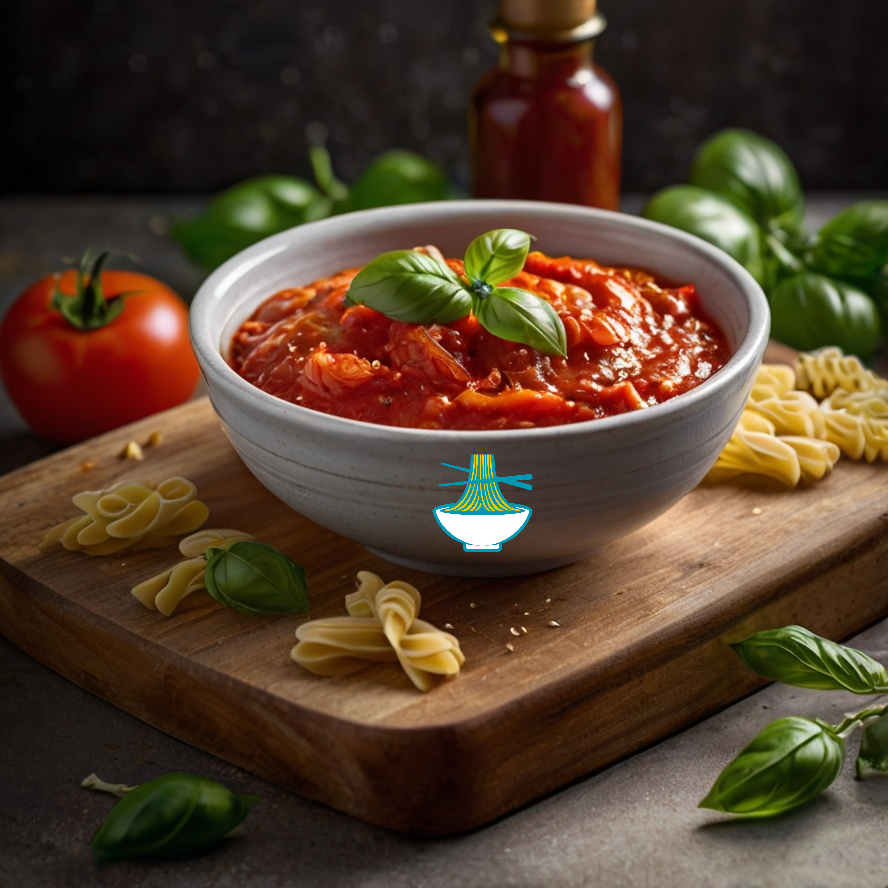Marinara Sauce is a timeless Italian classic, often used as a base for pasta dishes or pizza. Rich in flavor, it’s made with ripe tomatoes, garlic, onions, olive oil, and a blend of aromatic herbs like basil and oregano. The sauce is packed with antioxidants, particularly from the tomatoes, which are high in lycopene, known for promoting heart health. Garlic and onions provide additional benefits, supporting immune health and improving digestion. While Marinara Sauce can be a healthy addition to meals, it’s important to balance it with portion control, especially if paired with high-carb dishes. The sauce’s vibrant flavors make it a must-have in any kitchen for quick and delicious Italian-inspired meals.
Ingredients:
- 2 tablespoons olive oil
- 1 medium onion, finely chopped
- 4 cloves garlic, minced
- 2 cans (14 oz each) crushed tomatoes
- 1 teaspoon dried basil
- 1 teaspoon dried oregano
- 1/4 teaspoon red pepper flakes (optional)
- Salt and pepper to taste
- Fresh basil for garnish
Substitutes and Variations
- If you don't have dried basil or oregano, you can easily substitute them with fresh herbs. Fresh basil and oregano will provide a more aromatic and vibrant flavor.
- In case canned tomatoes aren't available, you can use fresh tomatoes or tomato paste mixed with water to achieve the desired consistency.
- Fresh garlic can be replaced with garlic powder in a pinch, though fresh garlic provides a more robust flavor.
For a richer sauce, you can add a splash of red wine or a spoonful of tomato paste.
Instructions:
Heat the Olive Oil
- Start by heating 2 tablespoons of olive oil in a large saucepan or skillet over medium heat. This will help the oil warm up and become ready to sauté the other ingredients. Olive oil is essential in this recipe as it adds flavor and acts as a base for cooking the onions and garlic.
Sauté the Onion
- Once the oil is hot, add 1 medium onion, finely chopped. Sauté the onion for about 5 minutes, stirring occasionally, until it becomes soft and translucent. The onion will begin to release its natural sweetness, enhancing the flavor of your sauce.
Add Garlic
- Add 4 cloves of garlic, minced, to the onions and cook for another minute. The garlic should become fragrant, which indicates that it’s releasing its aromatic oils and adding depth to the sauce. Be careful not to let it brown, as this can cause bitterness.
Add Crushed Tomatoes
- Next, pour in 2 cans of crushed tomatoes (14 oz each). Stir everything together to ensure the tomatoes are well combined with the onion and garlic mixture. The crushed tomatoes will form the base of your sauce and give it a smooth, rich texture.
Season with Herbs
- Add 1 teaspoon of dried basil and 1 teaspoon of dried oregano to the mixture. Stir to combine. These herbs are traditional in marinara sauce and will infuse the sauce with their aromatic flavors. For a touch of heat, you can also add 1/4 teaspoon of red pepper flakes at this point, depending on your spice preference.
Simmer the Sauce
- Reduce the heat to low and let the sauce simmer for 20-30 minutes, stirring occasionally. This step is crucial, as it allows the flavors to meld together and the sauce to thicken slightly. You can adjust the simmering time based on how thick or runny you prefer your sauce.
Season with Salt and Pepper
- After the sauce has simmered and developed its flavors, taste it and adjust the seasoning. Add salt and pepper to taste. The amount of salt will depend on how salty your canned tomatoes are, so be sure to taste and adjust accordingly.
Garnish and Serve
- Once your sauce is ready, remove it from the heat. Before serving, garnish with fresh basil leaves for an added layer of flavor and a beautiful pop of color. Fresh basil adds a bright, herbaceous note that complements the richness of the marinara.
Variety of Uses
Marinara sauce is incredibly versatile. It can be used as a base for a wide range of dishes. Here are some common uses:
- Pasta: It's a classic sauce for pasta dishes, from spaghetti to ravioli, adding a burst of flavor and nutrients.
- Pizza: Marinara sauce is often used as a pizza base, replacing traditional pizza sauce with a healthier, fresh alternative.
- Dipping Sauce: It makes an excellent dip for breadsticks, vegetables, or even mozzarella sticks.
- Topping for Meat Dishes: It can be poured over chicken, meatballs, or grilled fish to enhance the flavors and add a rich, savory element.
Tips for Improvement
- Storage: Marinara sauce can be stored in the refrigerator for up to 5 days. For longer storage, place it in an airtight container and freeze for up to 3 months. This is especially handy for meal prepping.
- Dietary Modifications:
- Low-fat option: Reduce the amount of olive oil to suit low-fat diets. You can also opt for less oil and use a bit of vegetable broth for cooking.
- Spicy version: Add extra red pepper flakes, chili peppers, or even hot paprika for those who enjoy a spicier kick.
- Vegan-friendly: This sauce is naturally vegan, but if you're using it with pasta or pizza, ensure your pasta or crust is vegan too.
Note:
Marinara Sauce: A Versatile and Nutritious Classic
- Marinara Sauce is a staple in Italian cuisine, known for its vibrant and rich flavor. It is made with simple ingredients such as ripe tomatoes, garlic, onions, olive oil, and a blend of aromatic herbs like basil and oregano. This sauce is not only delicious but also packed with nutrients, offering a variety of health benefits thanks to its ingredients.
Frequently Asked Questions (FAQs)
- Can Marinara Sauce be Stored? Yes, marinara sauce can be stored in the refrigerator for up to 5 days. For long-term storage, place the sauce in an airtight container and freeze it for up to 3 months.
- Can Marinara Sauce be Used in Diets? Yes, marinara sauce can be used in most diets, including Mediterranean, low-carb, and vegan diets. It's important to balance the oil and use fresh, wholesome ingredients for optimal health benefits.
- Can I Add Other Ingredients to Marinara Sauce? Absolutely! You can add ingredients like mushrooms, zucchini, or spinach to the sauce to increase its nutritional value. You can also enhance the flavor with herbs such as thyme, rosemary, or basil.
- Can I Use Marinara Sauce as a Tomato Sauce Substitute? Yes, marinara sauce can be used as a substitute for tomato sauce in many recipes. Its additional flavors from garlic, onions, and herbs will add complexity to any dish.
- What Are the Best Dishes to Pair with Marinara Sauce? Marinara sauce is perfect with a variety of dishes, such as:
- Pasta: Spaghetti, lasagna, or penne.
- Pizza: As a topping for homemade pizza.
- Meatballs: Served with spaghetti or as a topping for sandwiches.
- Grilled Vegetables: As a dipping sauce or drizzle.
- Is Marinara Sauce Gluten-Free? Yes, marinara sauce is naturally gluten-free, as it contains only tomatoes, olive oil, garlic, onions, and herbs. However, it's important to check that all ingredients, such as spices or packaged products, are certified gluten-free to avoid contamination.

Nutritional values and benefits:
Olive oil (2 tablespoons)
- Calories: 239
- Carbohydrates: 0g
- Protein: 0g
- Fat: 27g
Nutritional Benefit: Rich in healthy monounsaturated fats, supports heart health and reduces inflammation.
Onion (1 medium)
- Calories: 44
- Carbohydrates: 10g
- Protein: 1g
- Fat: 0g
Nutritional Benefit: Contains antioxidants and fiber, supporting heart health and digestive function.
Garlic (4 cloves)
- Calories: 16
- Carbohydrates: 4g
- Protein: 1g
- Fat: 0g
Nutritional Benefit: Known for its immune-boosting properties, garlic also supports heart health.
Crushed tomatoes (2 cans, 14 oz each)
- Calories: 140
- Carbohydrates: 28g
- Protein: 6g
- Fat: 0g
Nutritional Benefit: High in lycopene, an antioxidant that supports heart health and reduces cancer risk.
Dried basil (1 teaspoon)
- Calories: 1
- Carbohydrates: 0g
- Protein: 0g
- Fat: 0g
Nutritional Benefit: Adds flavor with minimal calories, and may help with digestion and inflammation.
Dried oregano (1 teaspoon)
- Calories: 3
- Carbohydrates: 1g
- Protein: 0g
- Fat: 0g
Nutritional Benefit: Rich in antioxidants, oregano has antibacterial properties and supports digestion.
Red pepper flakes (1/4 teaspoon)
- Calories: 1
- Carbohydrates: 0g
- Protein: 0g
- Fat: 0g
Nutritional Benefit: Adds a spicy kick to the sauce while boosting metabolism and circulation.
Fresh basil (for garnish)
- Calories: 1
- Carbohydrates: 0g
- Protein: 0g
- Fat: 0g
Nutritional Benefit: Rich in antioxidants, fresh basil adds flavor and may aid digestion.
Health Benefits
- Tomatoes: Tomatoes are the star ingredient of marinara sauce. They are rich in lycopene, a powerful antioxidant known for promoting heart health and potentially reducing the risk of certain cancers. Tomatoes also contain vitamin C, which boosts the immune system.
- Garlic: Garlic is known for its immune-boosting properties and may help lower cholesterol levels. It also aids in digestion and has anti-inflammatory effects.
- Olive Oil: Olive oil is rich in monounsaturated fats, which are heart-healthy fats that reduce inflammation and support cardiovascular health. It also provides an extra layer of flavor to the sauce.
Overall benefits: Marinara Sauce is not only delicious but also packed with nutrients. Tomatoes provide antioxidants, while garlic, onion, and herbs add immune-boosting and anti-inflammatory properties. Olive oil contributes heart-healthy fats, making this sauce a nutritious addition to any meal. However, it's important to keep in mind the amount of oil used and balance it with healthy portions of other ingredients for the best health benefits.


Comments